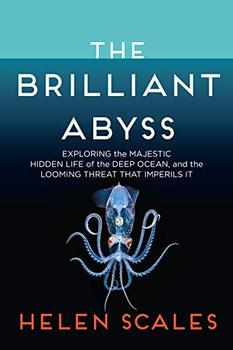Summary | Excerpt | Reviews | Beyond the Book | Readalikes | Genres & Themes | Author Bio

Exploring the Majestic Hidden Life of the Deep Ocean, and the Looming Threat That Imperils It
by Helen Scales
If you were to sail out into the open ocean and drop a glass marble over the side of the boat, for the first six or seven minutes it would fall through the uppermost layer of water, the part where the sun still shines. Some call this the epipelagic or euphotic zone, or simply the sunlit zone. It's the most familiar part of the oceans, where most of the known species live, and it's where all the oceans' photosynthesis takes place. The sun-catchers come in the form of large seaweeds as well as microscopic, single-celled creatures, collectively known as phytoplankton, which all suck in carbon dioxide and turn it into food for almost all the rest of ocean life.
As the marble drops, the sunlight fades until, at around 660 feet, there is just enough dim blue light to see by but not enough to power photosynthesis, and phytoplankton venture no deeper (at least while they're still alive). Here the marble enters the deep. Below, horizontal zones are laid out one above the other, like layers of Jello poured into a tall sundae glass. The uppermost layer, reaching downward from 660 feet, is the twilight zone (also known as the mesopelagic). The falling marble takes almost a half hour to pass through this zone of indigo dusk, until, at 3,300 feet, the twilight zone gives way to the permanent dark of the midnight zone (or bathypelagic). At this depth, the temperature, which has been falling, begins to level off. So far, the marble has been passing through the thermocline, where seawater rapidly cools, from the sun-warmed surface into the oceans' dark interior. Within the midnight zone, across most of the planet, water stays at a steady thirty-nine degrees Fahrenheit. It takes the marble another hour and a half to pass all the way through the midnight zone, at which point it reaches the next great portion of the deep, between around 13,000 and 20,000 feet down, the part of the deep sea now officially known as the abyss.
All through its journey toward the seafloor, the marble passes living creatures. Flashing lights glint in the glass sphere, not from sunlight but from the many light-making animals, the glowing worms and flashing lanternfish, which might wonder what kind of creature is blinking back at them. The marble would collect a dusting of organic matter, and tiny shrimp might take a ride while scraping up those particles of food. In open waters of the midnight zone, the marble could get knocked aside by the swish of a sperm whale's tail as it chases after a squid. It might bounce down the steep rocky walls of a canyon or land in a soft abyssal plain, perhaps next to a herd of sea cucumbers that look like small, pale piglets with too many legs, some with a spiny, red crab riding on their backs because there's nowhere else for it to hide. The marble could land on the flank of a seamount and get lost in tangled forests of immobile animals that have been living there for centuries, or it could fall next to a scorching hot spring gushing from cracks at a mid-ocean ridge and land among clusters of giant clams and huge worms with scarlet feathers.
Or, if your aim was good, the marble could plunge down into a trench and reach the hadal zone, the oceans' deepest layer. Even there, the glass sphere would pass living things, the blur of ghostly white fish. Then, eventually—six hours after you let it go at the surface—the marble would land at the very bottom, just shy of seven miles down, where it might attract a hungry swarm of pale crustaceans, eager to have a go at eating it.
A total tally of the number of deep-sea species is, of course, a long way out of reach given the deep's vast size, and systematic surveys have revealed glimpses of what is still to be found. In 1984, two American scientists, Fred Grassle and Nancy Maciolek, used a box corer, a tool like a giant cookie cutter, to extract chunks of mud from the deep seabed off the coasts of New Jersey and Delaware, between 4,900 and 8,200 feet down. Carefully sifting through the mud and picking out every tiny living thing—every worm, crustacean, starfish, sea cucumber, clam, and snail—they identified 798 species, over half of them new to science. Based on an average of three new species per square mile of seabed, Grassle and Maciolek estimated that abyssal plains across the planet could be home to thirty million species. The duo acknowledged that some regions of the deep may support a lower density of species, so they dialed down their estimate to a more cautious ten million.
Excerpted from The Brilliant Abyss by Helen Scales. Copyright © 2021 by Helen Scales. Excerpted by permission of Atlantic Monthly Press. All rights reserved. No part of this excerpt may be reproduced or reprinted without permission in writing from the publisher.
We must believe in luck. For how else can we explain the success of those we don't like?
Click Here to find out who said this, as well as discovering other famous literary quotes!
Your guide toexceptional books
BookBrowse seeks out and recommends the best in contemporary fiction and nonfiction—books that not only engage and entertain but also deepen our understanding of ourselves and the world around us.